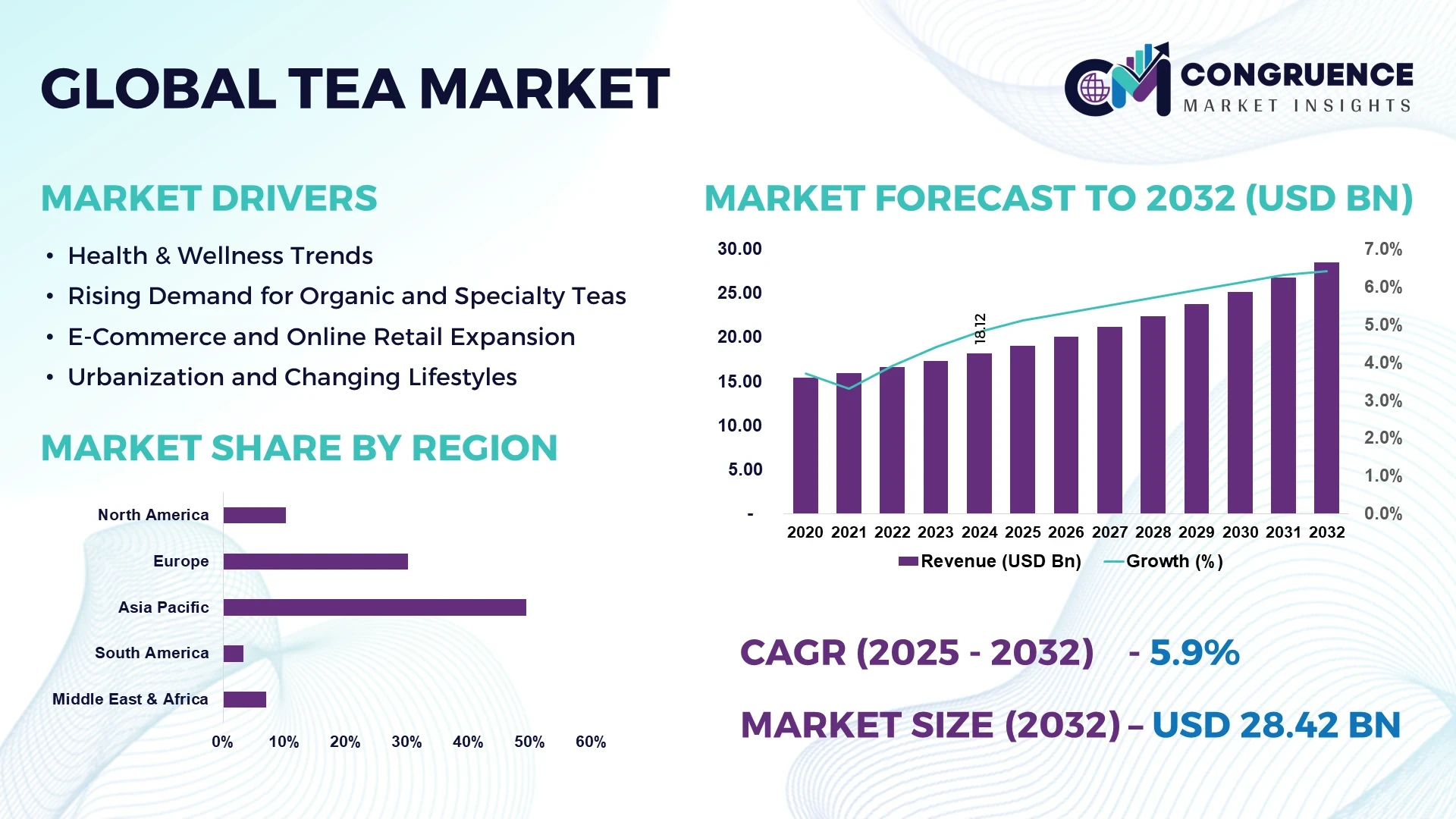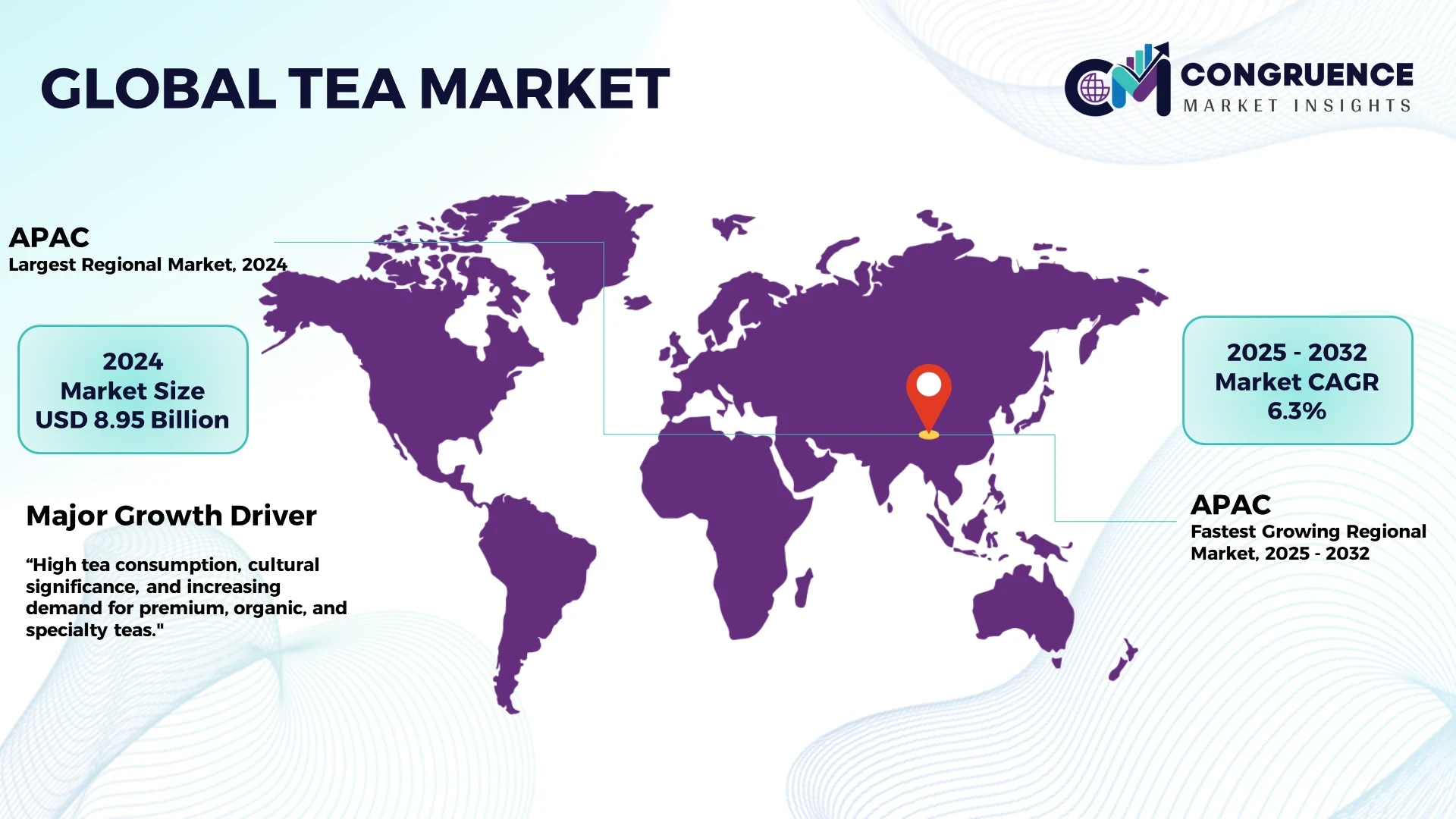Reports
Tea Market Size and Forecast 2025 to 2032
The Global Tea Market is valued at USD 18.12 Billion in 2024 and is projected to reach USD 28.42 Billion by 2032, growing at a CAGR of 5.9% during the forecast period between 2025 and 2032.

To Learn More About This Report, Request A Free Sample Copy
Tea, one of the world's most popular beverages, is important in many cultures and is valued for its health advantages, affordability, and variety. The tea market is steadily expanding, as people seek healthier beverage options that provide antioxidant characteristics, stress relief, and potential weight loss advantages. Various tea kinds, including black tea, green tea, herbal tea, and specialty mixes, are in high demand due to their supposed health advantages. Innovations in tea flavors, the growing appeal of organic teas, and expanding consumption in emerging economies are all driving market expansion. Furthermore, as consumers and producers become more concerned with environmental responsibility, sustainable sourcing and ethical agricultural techniques are becoming increasingly important trends in the tea industry. In 2024, the Asia Pacific region had the biggest market share, accounting for 49.4% of the total market value of USD 8.95 billion. The region is also predicted to expand the quickest throughout the forecast period, with a CAGR of 6.3%. Tea demand is fueled by rising health consciousness, a taste for natural beverages, and advancements in tea blends and formulations.
How AI is Transforming Tea Market
AI is transforming the tea industry by improving production efficiency, optimizing supply chains, and increasing consumer interaction. AI-powered drones and sensors monitor soil health, water levels, and plant conditions during cultivation, assisting farmers in maximizing productivity and reducing resource waste. AI systems can study weather patterns and forecast climate change, allowing tea farmers to adapt planting schedules and safeguard plantations from adverse conditions. AI helps to optimize manufacturing operations by automating sorting and quality control, ensuring that only the best tea leaves are processed. This leads to consistent product quality and lower labor expenses.
Furthermore, AI-powered robots are employed in tea packing, which increases manufacturing speed while reducing human mistake. AI has a tremendous impact on marketing and customer engagement. Machine learning algorithms use user preferences and purchasing behaviors to offer tailored tea products. Online shops use AI-powered chatbots to help clients select tea based on their taste preferences, resulting in a more interactive and personalized purchasing experience. As the tea sector modernizes, AI integration is projected to play a critical role in boosting overall supply chain efficiency, optimizing tea output, and increasing consumer happiness.
Tea Market Major Driving Forces
· Health & wellness trends: Growing consumer awareness of tea's health benefits, such as antioxidant qualities, stress relief, and digestive assistance, is propelling market expansion. Green and herbal teas, in particular, are becoming increasingly popular due to their supposed health benefits.
· Rising Demand for Organic and Specialty Teas: The growing demand for organic, fair-trade, and sustainably derived tea products is propelling the market forward. Consumers are also increasingly interested in specialty blends and flavored teas that include unusual combinations such as fruit infusions, spices, and herbs.
· E-Commerce and Online Retail Expansion: With the expansion of online retail platforms, consumers now have easier access to a diverse range of tea items from various countries. The convenience and accessibility of detailed product information have increased online tea sales.
· Urbanization and Changing Lifestyles: As cities grow and people live busier lives, there is a greater need for ready-to-drink tea and instant tea, catering to consumers who want convenience without sacrificing quality.
Tea Market Key Opportunities
· Growth of Functional and Medicinal Teas: As people become more interested in functional beverages with health advantages including immune boosters, detoxification, and relaxation, tea producers have more opportunity to innovate and introduce new products to health-conscious consumers.
· Sustainable & Eco-Friendly Packaging: The desire for eco-friendly packaging is encouraging businesses to use sustainable materials for tea bags and loose leaf packaging. Environmentally concerned customers are more inclined to select brands that value sustainability.
· Geographic Expansion: Emerging markets, particularly Latin America and Africa, provide considerable growth prospects as consumer demand for tea rises. Expansion into these markets through collaborations with local distributors can help boost growth.
· Technological Innovation in Tea Production: Advances in tea cultivation, such as AI-powered farming techniques and automated processing technology, provide opportunity for businesses to improve product quality while lowering production costs.
Tea Market Key Trends
· Premium and specialty teas are becoming increasingly popular, with consumers looking for unusual flavors, rare blends, and organic certifications. As consumers seek unique tea experiences, specialty teas such as matcha, oolong, and white tea are becoming increasingly popular.
· Ready-to-drink (RTD) Tea Growth: The ease of RTD tea beverages is appealing to younger, on-the-go consumers. RTD tea's rise is being driven by innovations in tastes, health-focused ingredients, and functional advantages.
· Growing Popularity of Herbal and Caffeine-Free Teas: Herbal teas, such as chamomile, peppermint, and ginger, are in high demand as customers seek caffeine-free options with health advantages.
· The tea business is shifting toward sustainability, with firms implementing eco-friendly methods like organic production, renewable energy, and sustainable packaging to attract environmentally concerned customers.
Region-wise Market Insights
Asia Pacifc is the largest market, accounting for 49.4% of the market share in 2024, valued at USD 8.95 Billion. Moreover, Asia Pacific is also predicted to expand at a fastest CAGR of 6.3% between 2025 and 2032.

To Learn More About This Report, Request A Free Sample Copy
In 2024, the Asia Pacific region dominated the worldwide tea market, accounting for 49.4% of the total, worth USD 8.95 billion. This region is predicted to experience the fastest growth, with a CAGR of 6.3% from 2025 to 2032. Countries like China, India, and Japan make significant contributions because to their long tea traditions and big consumer base. The rising popularity of green and herbal teas in these countries, combined with increased exports to Western markets, is propelling market expansion.
· In June 2024, Cranfield University and Lipton Tea and Infusions began collaborating on a project to enhance the sustainability of tea production. Their focus is on utilizing advanced agricultural technology and research to reduce environmental impact and improve efficiency in the supply chain, with the ultimate goal of making tea farming eco-friendlier. This partnership aims to address challenges like carbon emissions and water conservation.
The market in North America is booming as health awareness grows and specialty teas such as matcha and herbal mixes become more popular. The region's desire for organic and sustainably sourced tea products is also increasing, with businesses concentrating on environmentally responsible processes to match consumer tastes. Premium and organic teas are becoming increasingly popular in Europe, as customers gravitate toward health-conscious beverages. The UK, Germany, and France are major players in this sector, with the UK's strong tea culture generating steady demand.
Latin America, the Middle East, and Africa are emerging markets for tea, with rising disposable incomes and increased awareness of tea's health advantages driving global expansion. These regions provide chances for businesses wishing to broaden their regional reach.
Recent Market Developments
· In November 2024, Asian tea producers expressed interest in exploring the African market for tea exports, driven by growing demand and untapped potential in the region. According to the chairman of the Asian Tea Alliance (ATA), the African market presents opportunities to boost exports, especially in light of rising production costs and saturated markets elsewhere.
· In June 2024, African and Asian tea producers raised concerns about the growing demand-supply imbalance in the global tea market. Rising production costs and climate change impacts, combined with falling tea prices, are straining the industry. Producers seek global cooperation to address sustainability issues and ensure fair returns for tea growers.
· In April 2024, Yoshinoya partnered with Botrista to introduce new boba tea offerings to meet growing customer demand. The collaboration allows Yoshinoya to expand its beverage menu by incorporating boba tea flavors, which are becoming increasingly popular. Botrista's automated drink system enables efficient customization and preparation of these drinks in Yoshinoya outlets, enhancing the customer experience with unique and trendy options.
Market Competition Landscape
The global tea market is fiercely competitive, with top competitors prioritizing innovation, product variety, and sustainability to maintain market leadership. Major companies make significant investments in organic tea production, innovative tastes, and functional teas with health advantages. The demand for premium and specialty teas is fueling competitiveness, while sustainable and fair-trade practices are emerging as crucial differentiators.
Companies are also increasing their global footprint through smart mergers, acquisitions, and collaborations to strengthen distribution networks, particularly in emerging regions. Leading firms are also investing in digital marketing and e-commerce platforms to reach a larger audience. Regional players who cater to distinct customer preferences and local interests ratchet up competition. Sustainability measures, such as eco-friendly packaging and sustainable farming techniques, are reshaping the competitive landscape, with companies who emphasize these activities gaining an advantage.
Key players in the global tea market implement various organic and inorganic strategies to strengthen and improve their market positioning. Prominent players in the market include:
· Unilever (Lipton)
· The Coca-Cola Company (Honest Tea)
· Nestlé (Nestea)
· Associated British Foods (Twinings)
· Barry's Tea
· Bigelow Tea Company
· Harney & Sons Fine Teas
· Hain Celestial Group (Celestial Seasonings)
· The Republic of Tea
· Ahmad Tea
· DavidsTea
· ITO EN
|
Report Attribute/Metric |
Details |
|
Market Revenue in 2024 |
USD 18.12 Billion |
|
Market Revenue in 2032 |
USD 28.42 Billion |
|
CAGR (2025 – 2032) |
5.9% |
|
Base Year |
2024 |
|
Forecast Period |
2025 – 2032 |
|
Historical Data |
2020 to 2024 |
|
Forecast Unit |
Value (US$ Bn) |
|
Key Report Deliverable |
Revenue Forecast, Growth Trends, Market Dynamics, Segmental Overview, Regional and Country-wise Analysis, Competition Landscape |
|
Segments Covered |
· By Type (Black Tea, Green Tea, Herbal Tea, Oolong Tea, and Others) · By Packaging (Loose Tea, Tea Bags, Instant Tea, and Others) · By Distribution Channel (Supermarkets/Hypermarkets, Specialty Stores, Online, and Others) · By End-User (Household, Commercial) |
|
Geographies Covered |
North America: U.S., Canada and Mexico Europe: Germany, France, U.K., Italy, Spain, and Rest of Europe Asia Pacific: China, India, Japan, South Korea, Southeast Asia, and Rest of Asia Pacific South America: Brazil, Argentina, and Rest of Latin America Middle East & Africa: GCC Countries, South Africa, and Rest of Middle East & Africa |
|
Key Players Analyzed |
Tata Consumer Products, Unilever (Lipton), The Coca-Cola Company (Honest Tea), Nestlé (Nestea), Associated British Foods (Twinings), Barry's Tea, Bigelow Tea Company, Harney & Sons Fine Teas, Hain Celestial Group (Celestial Seasonings), Dilmah Tea, The Republic of Tea, Ahmad Tea, DavidsTea, ITO EN |
|
Customization & Pricing |
Available on Request (10% Customization is Free) |
